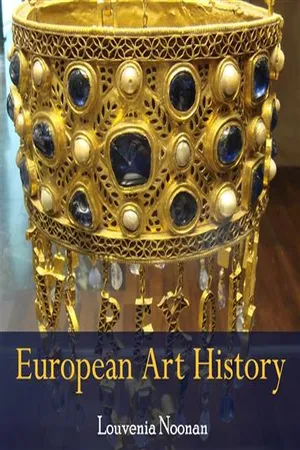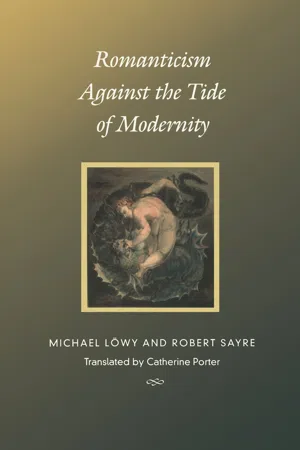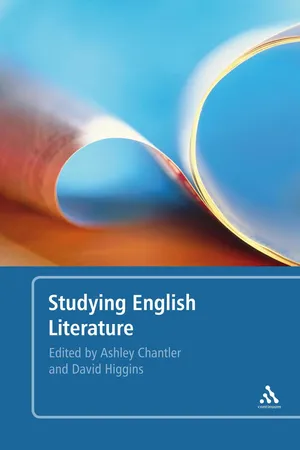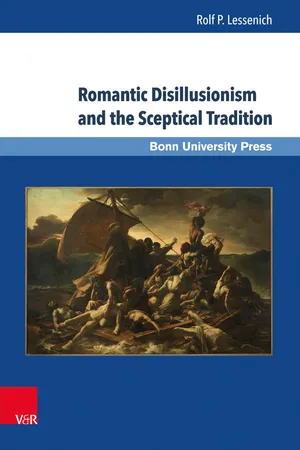Literature
Dark Romanticism
Dark Romanticism is a literary movement that emerged in the 19th century, characterized by a focus on the darker aspects of human nature, the supernatural, and the macabre. Writers of this movement often explored themes of death, sin, and the psychological effects of guilt and madness. Dark Romanticism is known for its emphasis on the mysterious and the irrational, often challenging traditional notions of beauty and morality.
Written by Perlego with AI-assistance
Related key terms
1 of 5
4 Key excerpts on "Dark Romanticism"
- No longer available |Learn more
- (Author)
- 2014(Publication Date)
- The English Press(Publisher)
The modern sense of a romantic character may be expressed in Byronic ideals of a gifted, perhaps misunderstood loner, creatively following the dictates of his inspiration rather than the mores of contemporary society. Although the movement was rooted in the German Sturm und Drang movement, which prized intuition and emotion over Enlightenment rationalism, the ideologies and events of the French Revolution laid the background from which both Romanticism and the Counter-Enlightenment emerged. The confines of the Industrial Revolution also had their influence on Romanticism, which was in part an escape from modern realities; indeed, in the second half of the 19th century, Realism was offered as a polarized opposite to Romanticism. Romanticism elevated the achievements of what it perceived as heroic individualists and artists, whose pioneering examples would elevate society. It also legitimized the individual imagination as a critical authority, which permitted freedom from classical notions of form in art. There was a strong recourse to historical and natural inevitability, a zeitgeist , in the representation of its ideas. Characteristics In a basic sense, the term Romanticism has been used to refer to certain artists, poets, writers, musicians, as well as political, philosophical and social thinkers of the late 18th and early to mid 19th centuries. It has equally been used to refer to various artistic, intellectual, and social trends of that era. Despite this general usage of the term, a precise characterization and specific definition of Romanticism have been the subject of debate ________________________ WORLD TECHNOLOGIES ________________________ in the fields of intellectual history and literary history throughout the twentieth century, without any great measure of consensus emerging. - eBook - PDF
- Michael Löwy, Robert Sayre, Catherine Porter, Fredric Jameson, Stanley Fish, Catherine Porter, Fredric Jameson, Stanley Fish(Authors)
- 2002(Publication Date)
- Duke University Press Books(Publisher)
At the same time, a cult of sentiment and subjectivity was emerging, with an emphasis on their lugubrious and melancholic dimen-sions, along with a celebration of nature and a critique of the market spirit and industrialization. Nostalgia for the past is manifested in particular in the Ossianic poems (1762) of James Macpherson; in the Gothic novel, beginning with Horace Walpole’s Castle of Otranto (1764); and also in the fashion for imitating various ancient styles in architecture and the decorative arts. Regarding sentiment and nature, let us mention the Graveyard School of Thomas Gray, Edward Young, and William Collins. And let us cite one example among many others, Oliver Goldsmith’s ‘‘The Deserted Village’’ (1770), a poem that brings all these themes together and denounces the commercialization of England from a Tory perspective: redefining romanticism 53 Ill fares the land, to hastening ills a prey, Where wealth accumulates and men decay . . . But a bold peasantry, their country’s pride, When once destroyed, can never be supplied. A time there was, ere England’s griefs began, When every rood of ground maintained its man; For him light labour spread her wholesome store, Just gave what life required, but gave no more . . . But times are altered; trade’s unfeeling train Usurp the land and dispossess the swain. . . . ∞∞∑ France The movement of ideas in France was very heavily dominated by the Ency-clopedia and the Enlightenment in the second half of the eighteenth century. Early French Romanticism was expressed mainly in the arts and literature but was also found in religion, especially starting around 1770 with the burgeoning of illuminist and theosophic sects, which were often apocalyp-tic, millennial. - eBook - PDF
- Ashley Chantler, David Higgins, Ashley Chantler, David Higgins(Authors)
- 2010(Publication Date)
- Continuum(Publisher)
Part III Studying Romantic and Victorian Literature (1789–1901) This page intentionally left blank The Romantic Period 7 David Higgins Chapter Overview Historical Context 113 Key Authors and Texts 117 Criticism and Literary Theory 123 Case Study: William Wordsworth’s Poetry 126 Case Study: Jane Austen’s Pride and Prejudice 129 Further Reading 133 Historical Context The ‘Romantic Period’ is tricky to pin down. It generally refers a period from about 1780 to about 1830, but there is no consensus over precise start or end dates. The problem is that the adjective ‘Romantic’ and its associated noun ‘Romanticism’ are used to describe a diverse set of responses to com-plex socio-cultural changes that took place in western Europe during about a century. Critics and historians have struggled over the years to define Romanticism and A. O. Lovejoy famously argued in ‘On the Discrimination of Romanticisms’ (1924) that the term was used so broadly that it had become effectively meaningless. Romanticism has tended to be associated with certain concepts and areas of human experience: for example, feeling, revolution, the imagination, nature, and introspection. It has often been contrasted with eighteenth-century literature’s emphasis on reason, order, imitation, urban life, and sociability. However, once you start to unpack these grand general-izations, they become increasingly hard to sustain. For example, plenty of eighteenth-century literature is introspective, and plenty of Romantic litera-ture is interested in sociability (see Cox; James; and Russell and Tuite). And, as discussed in the previous chapter, the focus on the relationship between self and landscape that you see in many Romantic-period texts has its roots 113 in the work of eighteenth-century poets such as Collins, Cowper, Gray, and Thomson. - Rolf P. Lessenich(Author)
- 2017(Publication Date)
- V&R Unipress(Publisher)
Ro- manticism must become silence – or accommodation. 147 This is also the case with American Romanticism, and explains why the later American Romantics – Edgar Allan Poe, Nathaniel Hawthorne, and Herman Melville – insisted on the reality and ultimate ineradicability of the “power of blackness” 148 in man. It is true that Poe and Melville were Romantic Dis- illusionists and Hawthorne a Positive Romantic, whose conversations with the sceptic Melville attest to his strained efforts to maintain and teach his Christian faith. But their common Dark Romantic fiction argued against the optimism of the Platonic American Transcendentalists, manifested in their recourse to themes and techniques of the Gothic novel with its powerful and ever-present primeval demonism, subterranean vaults underneath splendid castles or churches, dark impenetrable forests, banditti and inquisitors, and dark Gothic villains and villainesses. The black characters in Melville’s “Benito Cereno” (1856), Babo and Atufal, are not only poor victims of slavery, commanding the reader’s sympathy, but, with the cruelty and guile of their revolt, they also embody the power of evil in man and history. The haunting dark forests in Hawthorne’s “Young Goodman Brown” (1835) and The Scarlet Letter (1850) symbolize primeval sin and the re-enactment of the Fall of man, forever to be repeated, although his Gothic, like Coleridge’s, was a Christian Gothic allowing for the possibility of weak man’s redemption. Nevertheless, any Emersonian perfectibility, Paradise Regained in this world, is then quite impossible. Wars, 147 Nemoianu, The Taming of Romanticism, 29. 148 Harry Levin, The Power of Blackness, New York 1958. Introduction 55
Index pages curate the most relevant extracts from our library of academic textbooks. They’ve been created using an in-house natural language model (NLM), each adding context and meaning to key research topics.



